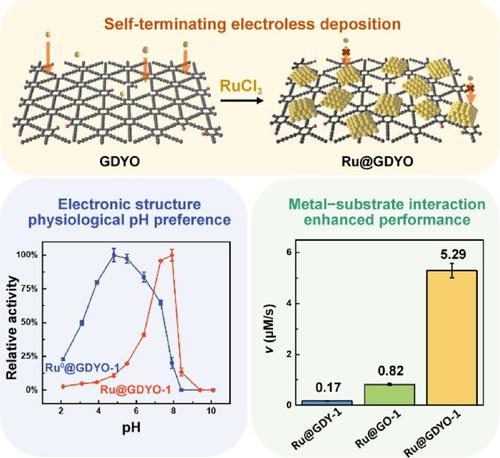Nano Research ( IF 9.5 ) Pub Date : 2023-07-27 , DOI: 10.1007/s12274-023-5931-4 Cong Xu , Wenjie Ma , Haozhi Wang , Leihou Shao , Weiqi Li , Ping Yu , Lanqun Mao

|
Modulating electronic structure of metal nanoparticles via metal–support interaction has attracted intense interest in the field of catalytic science. However, the roles of supporting substrates in regulating catalytic properties of nanozymes remain elusive. In this study, we find that the use of graphdiyne oxide (GDYO) as the substrate for self-terminating growth of Ru nanoparticles (Ru@GDYO) endows the peroxidase-like activity of Ru nanoparticles with intrinsic physiological pH preference and natural horseradish peroxidase (HRP) comparable performance. Ru nanoparticles electrolessly deposited onto GDYO possess a partially oxidized electronic structure owing to limited charge transfer between Ru and GDYO, contributing to the intrinsic physiological pH preference of the peroxidase-mimicking nanozyme. More importantly, the substrate GDYO plays an influential factor in enhancing catalytic activity, that is, the activity of Ru@GDYO is much higher than that of Ru nanoparticles deposited on other carbon substrates including graphene oxides and graphdiyne. To demonstrate the application of Ru@GDYO nanozyme in neutral solutions, we employ Ru@GDYO with nicotinamide adenine dinucleotide (NAD+)-dependent dehydrogenases in physiological conditions to realize a sustainable cascade reaction by means of forming continuous NAD+/dihydronicotiamide adenine dinucleotide (NADH) recycling. Our finding represents a promising perspective on designing high-performance peroxidase-mimicking nanozymes with broader applicability, raising fundamental understanding of structure–activity relationship, and investigating new applications of nanozymes in biological systems.
中文翻译:

氧化石墨炔底物增强了具有生理 pH 偏好的 Ru 纳米粒子的过氧化物酶模拟性能
通过金属-载体相互作用调节金属纳米颗粒的电子结构引起了催化科学领域的浓厚兴趣。然而,支撑底物在调节纳米酶催化性能中的作用仍然难以捉摸。在这项研究中,我们发现使用氧化石墨炔(GDYO)作为自我终止生长Ru纳米颗粒(Ru@GDYO)的底物赋予了Ru纳米颗粒类似过氧化物酶的活性,具有内在的生理pH偏好和天然辣根过氧化物酶( HRP)可比的性能。无电沉积在 GDYO 上的 Ru 纳米粒子由于 Ru 和 GDYO 之间有限的电荷转移而具有部分氧化的电子结构,有助于模拟过氧化物酶的纳米酶的内在生理 pH 偏好。更重要的是,基质GDYO对增强催化活性起着影响因素,即Ru@GDYO的活性远高于沉积在其他碳基质(包括氧化石墨烯和石墨二炔)上的Ru纳米颗粒的活性。为了演示Ru@GDYO纳米酶在中性溶液中的应用,我们在生理条件下使用Ru@GDYO与烟酰胺腺嘌呤二核苷酸(NAD+)依赖性脱氢酶,通过形成连续的NAD+/二氢烟酰胺腺嘌呤二核苷酸(NADH)来实现可持续的级联反应回收。我们的发现代表了设计具有更广泛适用性的高性能过氧化物酶模拟纳米酶、提高对结构-活性关系的基本理解以及研究纳米酶在生物系统中的新应用的有前景的前景。Ru@GDYO 的活性远高于沉积在其他碳基底(包括氧化石墨烯和石墨二炔)上的 Ru 纳米粒子。为了演示Ru@GDYO纳米酶在中性溶液中的应用,我们在生理条件下使用Ru@GDYO与烟酰胺腺嘌呤二核苷酸(NAD+)依赖性脱氢酶,通过形成连续的NAD+/二氢烟酰胺腺嘌呤二核苷酸(NADH)来实现可持续的级联反应回收。我们的发现代表了设计具有更广泛适用性的高性能过氧化物酶模拟纳米酶、提高对结构-活性关系的基本理解以及研究纳米酶在生物系统中的新应用的有前景的前景。Ru@GDYO 的活性远高于沉积在其他碳基底(包括氧化石墨烯和石墨二炔)上的 Ru 纳米粒子。为了演示Ru@GDYO纳米酶在中性溶液中的应用,我们在生理条件下使用Ru@GDYO与烟酰胺腺嘌呤二核苷酸(NAD+)依赖性脱氢酶,通过形成连续的NAD+/二氢烟酰胺腺嘌呤二核苷酸(NADH)来实现可持续的级联反应回收。我们的发现代表了设计具有更广泛适用性的高性能过氧化物酶模拟纳米酶、提高对结构-活性关系的基本理解以及研究纳米酶在生物系统中的新应用的有前景的前景。我们在生理条件下将Ru@GDYO与烟酰胺腺嘌呤二核苷酸(NAD+)依赖性脱氢酶结合使用,通过形成连续的NAD+/二氢烟酰胺腺嘌呤二核苷酸(NADH)循环来实现可持续的级联反应。我们的发现代表了设计具有更广泛适用性的高性能过氧化物酶模拟纳米酶、提高对结构-活性关系的基本理解以及研究纳米酶在生物系统中的新应用的有前景的前景。我们在生理条件下将Ru@GDYO与烟酰胺腺嘌呤二核苷酸(NAD+)依赖性脱氢酶结合使用,通过形成连续的NAD+/二氢烟酰胺腺嘌呤二核苷酸(NADH)循环来实现可持续的级联反应。我们的发现代表了设计具有更广泛适用性的高性能过氧化物酶模拟纳米酶、提高对结构-活性关系的基本理解以及研究纳米酶在生物系统中的新应用的有前景的前景。































 京公网安备 11010802027423号
京公网安备 11010802027423号